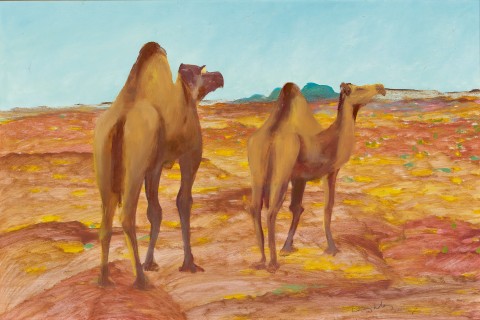CAMELS IN THE DESERT, 1951
SIDNEY NOLAN
Ripolin enamel and red ochre oil paint on composition board
60.0 x 90.5 cm
signed and dated lower right: Sidney Nolan / 1951
Artarmon Public School, Sydney, a gift from the artist, 1953
Sotheby's, Melbourne, 30 July 1986, lot 84
The collection of Lord McAlpine of West Green, United Kingdom
Lauraine Diggins Fine Art, Melbourne (label attached verso)
The National Australia Bank Art Collection, acquired from the above in March 1995 (label attached verso)
Sidney Nolan: Burke and Wills, S. H. Ervin Gallery, The National Trust of Australia, Sydney, 7 November 1985 – 26 January 1986
Sidney Nolan: Landscapes and Legends, National Gallery of Victoria, Melbourne, 3 June — 26 July 1987, and touring to Art Gallery of New South Wales, Sydney, 11 August — 27 September 1987; Art Gallery of Western Australia, Perth, 21 October — 29 November 1987; Art Gallery of South Australia, Adelaide, 15 December 1987 — 31 January 1988 (label attached verso)
Different Views: Aspects of the Landscape, Lauraine Diggins Fine Art, Melbourne, 15 March - 13 April 1995, cat. 30
Sidney Nolan: Desert and Drought, National Gallery of Victoria, Melbourne, 6 June — 17 August 2003, cat. 17 (label attached verso)
McCauley, C., 'Nolan's deserted camels emerge from dark at bottom of stairs', The Australian, Sydney, 24 September 1985, p. 3 (illus.)
Clark, J., Sidney Nolan Landscapes & Legends, Cambridge University Press, Melbourne, 1987, p. 108 (illus.)
Smith, G., Sidney Nolan: Desert and Drought, National Gallery of Victoria, Melbourne, 2003, cat. 17, p. 147
Smee, S., ‘Fred Williams and Company’, in Hart, D., Fred Williams: Infinite Horizons, National Gallery of Australia, Canberra, 2011, p. 214 (illus.)
Camels, Central Australia, 1950, Ripolin enamel and red ochre oil paint on composition board, 122.0 x 152.0 cm, in the collection of the Reserve Bank of Australia, Sydney
06.jpg

Sidney Nolan travelled extensively through Central Australia in 1949 and in addition to transforming his understanding of the country, the experience revolutionised his vision of the landscape. In a letter to his friend and fellow artist, Albert Tucker, in January 1950, he wrote: ‘We had a wonderful trip to the back of beyond, it is really the proper Australia, old, dignified and coherent… We did a lot of flying in small mail planes & …we just about covered the whole area of the inland …the country in itself has a powerful charm. The light reveals everything in a microscopic way & colours carry for almost frightening distances… Such intensity & duration of colour gives you quite a strange feeling for a while. Anyway it is around this point that I seem to be painting now.’1
Dated 1951, although possibly painted two years earlier, Camels in the Desert exemplifies this approach, the dark red ochre and citrus orange of the dry ground extending deep into the distance and emphasising the overwhelming vastness of the land.2 The brilliant intensity of the desert light which Nolan described as opalescent, ‘like mother-of-pearl and … glowing in transparent layers’3 is miraculously captured in paint, the bleached blue sky appearing to radiate with light and heat. To achieve this, Nolan used enamel paint, noting that, ‘in order to reproduce this light… which was flooding over everything, one had to adopt a different sort of palette from the conventional oil palette one and Ripolin on masonite seemed to… set up the effect I wanted’.4 His practice was to begin by priming composition board panels with a white ground which he sometimes exposed by scraping subsequent paint layers away. The sheen of enamel paint, evenly applied across the smooth surface of the painting support, also contributed to the luminosity of these paintings by reflecting external sources of light.
The subject of camels in the desert featured in numerous works around this time and is perhaps most familiar from the Burke and Wills series painted between 1948-50, in which the intrepid but ultimately doomed explorers are often depicted with the camels that were such a critical part of their expedition to cross Australia. In relation to these paintings Nolan wrote of ‘the strange conjunction of a man on a camel, from which he surveys the landscape as if he is walking on giant stilts’.5 In the 1961 series that reprises the subject, the explorers and their camels are depicted in a much more abstract way, Nolan’s technique and palette merging them with their surroundings so that they are almost part of the landscape. In this picture too, Nolan’s palette is deliberately pared back and the camels, painted the same colour as the desert, are connected visually and metaphorically to the country they inhabit. Cynthia Nolan summed up this idea in words, writing to her sister in 1949, ‘Sidney is dreaming camels … Cattle & horses & white men do not fit this country.’6
1. Sidney Nolan to Albert Tucker, 26 January 1950, quoted in McCaughey, P., (ed.), Bert & Ned: The Correspondence of Albert Tucker and Sidney Nolan, The Miegunyah Press, Carlton, 2006, p. 110
2. The painting is dated 1951, however Geoffrey Smith gives the earlier date of 1949 in the exhibition catalogue, Sidney Nolan: Desert and Drought, noting that the 1951 inscription was made later, in 1953. See Smith, G., Sidney Nolan: Desert and Drought, National Gallery of Victoria, Melbourne, 2003, cat. 17, p. 147
3. Sidney Nolan quoted in Lynn, E., and Nolan, S., Sidney Nolan – Australia, Bay Books, 1979, p. 180
4. Smith, op. cit., p. 22
5. Rosenthal, T. G., Sidney Nolan, Thames & Hudson, London, p. 122
6. Cynthia Nolan to Margaret Reed, Turner Station, postmarked 9 September 1949, Jinx Nolan Papers quoted in Smith, op. cit., p. 39
KIRSTY GRANT
